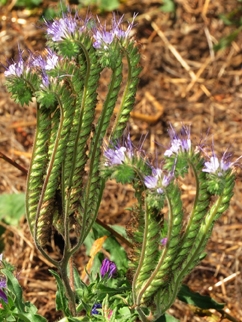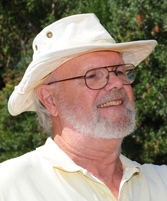Posts Tagged: native plant restoration
Honey bees: Should they be banned from native plant restoration areas?
What’s a honey bee to do?
The dwindling resources of pollen and nectar-producing plants in California greatly concern bee scientists and beekeepers, and rightfully so.
But the dwindling resources also greatly concern native pollinator specialists and native plant enthusiasts. Some worry that honey bees, which are non-natives, may be "reducing" or "eliminating" native pollinators through competition for food.
Are they?
Extension apiculturist Eric Mussen of the UC Davis Department of Entomology and Nematology explains that a number of agencies and organizations are cooperating in an effort to "restore" regions of the California Central Valley to their "original state."
“The major emphases are (1) replacing non-native vegetation with native plants and (2) encouraging native animals to return to their former ranges,” Mussen says. "The result has been eviction of beekeepers from apiary locations that have been used for decades as seasonal spots for rebuilding populations following the stresses of commercial pollination or for producing honey."
“While removing this non-native pollinator from an environment may sound rational at first, it may not be the best idea,” Mussen points out. “In most cases, it is not the presence of honey bees that has depressed or eliminated the populations of native pollinators. In fact, no studies have shown that honey bees eliminate native pollinators. In some cases, the populations of native pollinators have been reduced by honey bee competition, but following removal of honey bees the native bees built back to usual levels in a couple years.”
Indeed, in some situations, honey bees can survive, and native pollinators can’t.
“With honey bees, if we provide them with an adequate hive and food sources, they are likely to survive,” Mussen says. “However, native pollinators can be very particular about the environment in which they can exist. If their nesting habitat is disturbed, modified or destroyed, they cannot live in the area, despite an abundance of food plants. In many California locations, it is habitat alteration or destruction, not lack of food, which eliminated the native pollinators.”
When native habitats are compromised, “honey bees may be essential to foster initial re-establishment of native plant populations,” Mussen relates. “Those plants provide food and shelter for wildlife and assist significantly in erosion control. Until the habitat is restored adequately to meet the requirements of native pollinators, it is likely that the presence of honey bees will be much more beneficial than detrimental in keeping the California native plants pollinated and reproducing.”
So, should honey bees be banned from restoration areas?
"No," Mussen says. "Honey bees should be solicited for restoration areas, not banned."
Mussen shares a list of 130 native California plants that are likely to be visited - "and probably pollinated" - by honey bees. They include button bush or button willow, fiddleneck, and California golden poppy. The list is excerpted from Nectar and Pollen Plants of California by G. H. Vansell UC Berkeley, plus personal observations by native pollinator specialist Robbin Thorp, UC Davis emeritus professor of entomology. The list is updated, reflecting information on the CalFlora website and the Jepson Manual of Higher Plants of California.
Thorp, who monitors the Häagen-Dazs Honey Bee Haven, planted in the fall of 2009 on Bee Biology Road, UC Davis, has found more than 80 different species of bees - and counting - in the half-acre bee garden. It's located next to the apiary at the Harry H. Laidlaw Jr. Honey Bee Research Facility.
So honey bees and native bees share the resources.
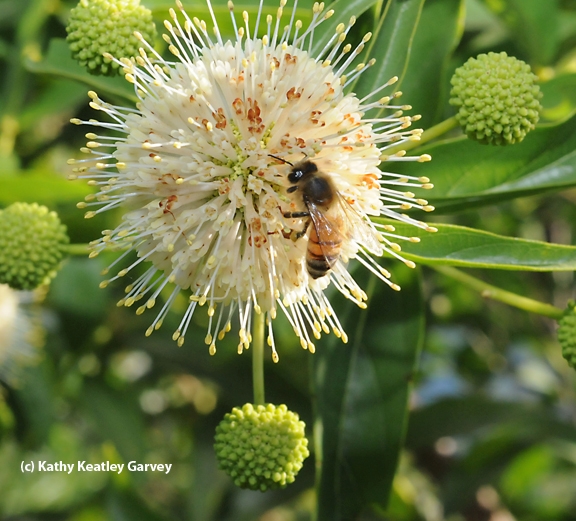
A honey bee foraging on button willow, also known as button bush, Cephalanthus occidentalis. Honey bees on non-natives, and the button bush is a native California plant. (Photo by Kathy Keatley Garvey)
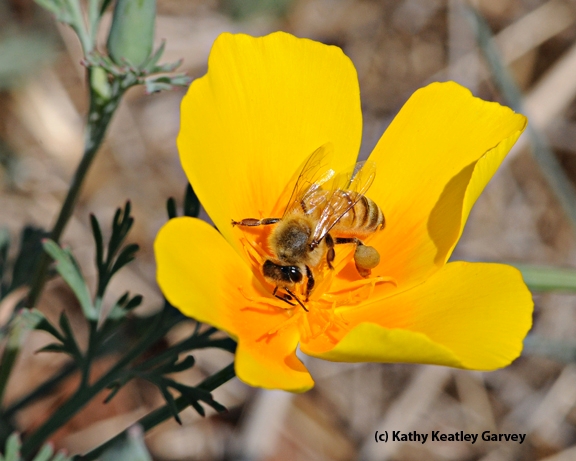
Honey bee visiting California golden poppy, Eschscholzia spp. (Photo by Kathy Keatley Garvey)
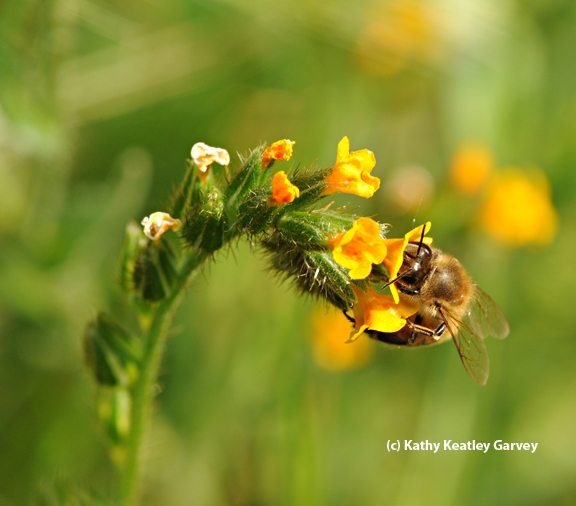
Honey bee foraging on fiddleneck, Amsinckia spp. (Photo by Kathy Keatley Garvey)


